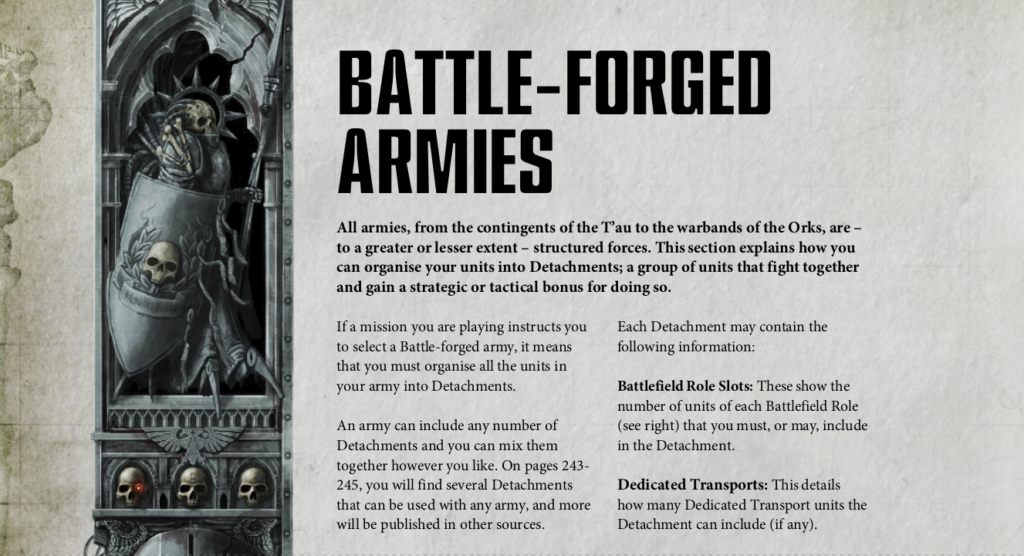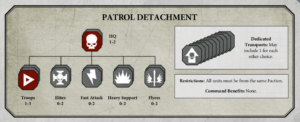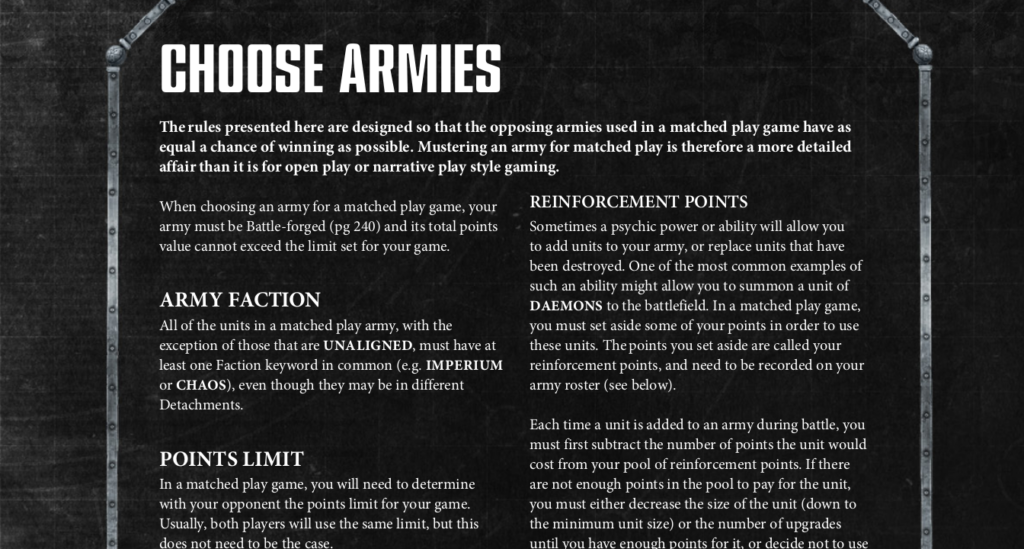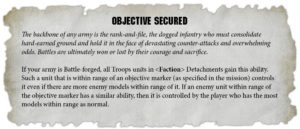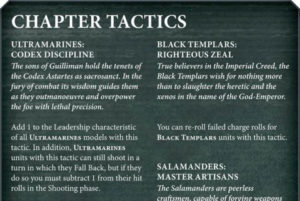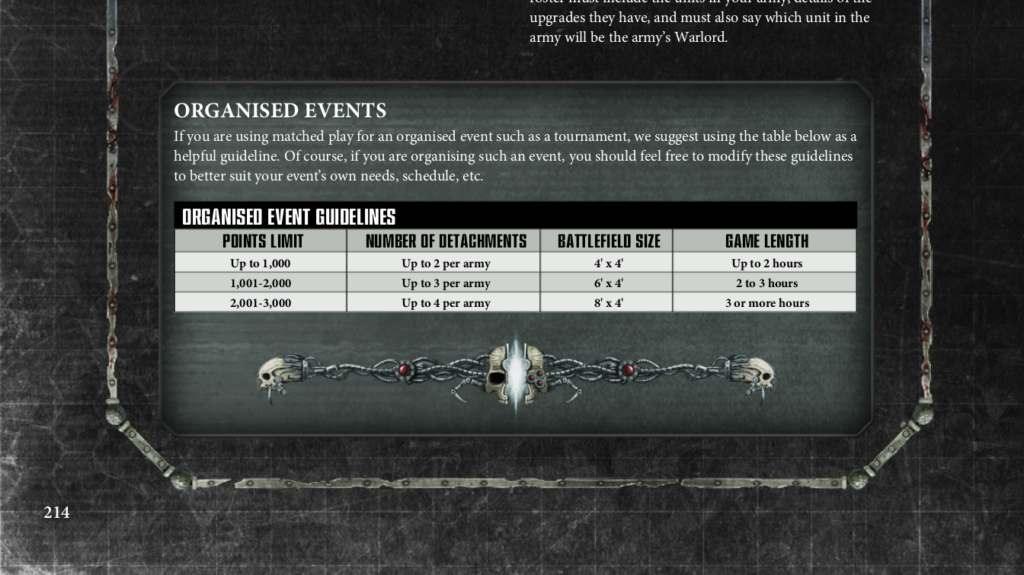Questions about army list building in Warhammer 40,000 8th edition continue to come up as newcomers join the hobby and old heads return. So I’m going to write my explanation about detachments, Battle Forged, and so on here just one more time and then link to it in future conversations. Corrections and questions are welcome.
TL;DR
For Matched Play, the most common 40k 8e format, armies must be organized into detachments and all units across the entire army must have at least one faction keyword in common (e.g., Imperium). Additional buffs are available for detachments (not armies) drawn from single codexes or factions (e.g., Space Marine chapters).
Background
My impression is that most players are generally using the Matched Play format, as opposed to Open Play, Narrative, or something else ad hoc. I could be wrong about that in general, but it’s certainly true of pickup play around my local scene (Redcap’s Corner) and all the tournaments I have seen (and run). So the default is that you’re selecting armies by points, not power levels, and adhering to Matched Play format.
Hampering newcomers in hunting down rules is that Matched Play is actually more restrictive than Battle Forged. Many people implicitly assume Battle Forged is more fluffy and limited. That’s not the case. Matched Play is a subset of Battle Forged, not the other way around. Competition-oriented Matched Play and some newer rules additions from the codexes and upcoming Chapter Approved supplement actually do more to encourage armies more similar to traditional Force Org Chart, no allies, old-school 40k. Battle Forged by itself is more open.
Battle Forged
Matched Play requires that your armies be Battle Forged (main rulebook page 214, top left). Battle Forged requires your entire army to be organized into one or more detachments (main rulebook page 240, top left).
Detachments in theory are wide open, you can put any mix of units in there. However, in practice all of the units within a detachment must share at least one keyword. All of the detachments in the main rulebook such as Patrol, Battalion, Outrider, and so on either explicitly impose that restriction or are limited to a single unit. The only exception is the Fortification Network, which permits multiple fortifications with no faction restriction. There are some faction specific fortifications out right now, such as the Tau Tidewall, but most published so far are Unaligned (the commonly seen ones are all in Index Imperium 2), and this is mostly a small side point anyway.
Unless I’ve missed something, no other detachments have been published or rumored. So, in the future some supplement or such could perhaps have a detachment that permitted you to include Orks and Imperial Guard within a single detachment. However, you cannot do that within any of the detachments that currently exist because those units do not share any faction keywords. What you can do though is, for example, make up a detachment of Imperial Guard and Ultramarines units, because those all share at least one faction keyword (Imperium).
In addition, under Battle Forged rules alone, your army could straddle factions across multiple detachments. You could, for example, make up a Battle Forged army that had two detachments of Imperial Guard and one of Orks. There are no rules for Battle Forged armies linking the detachments.
Matched Play
However, Matched Play prohibits that by imposing such a linkage. Matched Play requires that armies be Battle Forged and that all units have at least one faction keyword in common (main rulebook page 214, under “Army Faction”).
So, in a tournament or pickup play using Matched Play rules, you could not field an army with detachments of Imperial Guard and Orks even though it was Battle Forged. You can however still mix Imperial Guard and Ultramarines units within and across detachments, because those all share at least one keyword.
Faction Buffs
New rules from the codexes released to date as well as the upcoming Chapter Approved supplement however encourage—but do not require—detachments drawn from a single faction by offering at least four types of buffs for doing so.
Objective Secured
The codexes seen so far all have rules, such as the Space Marines’ Defenders of Humanity, that give a scoped but important buff to models in a detachment comprised solely of units from that codex: They trump other models for control of objectives. The Chapter Approved supplement will provide a similar rule, Objective Secured, for all the factions that still only have Indexes. Most events seem to be adopting this and the other updates to Matched Play from this supplement that have been officially previewed. There’s a reason GW rushed out these rules previews just in time for the first really large 40k event under 8th edition (NOVA): They address a number of balance issues, particularly as the codexes roll out.
Stratagems
Similarly, codex stratagems are unlocked by fielding at least one detachment comprised solely of units from that codex. So a detachment made up of Imperial Guard and Space Marines would be Battle Forged, share a keyword, and be legal in Matched Play, but by itself it would not have access to either of those codexes’ stratagems. That’s a severe penalty for mixing the factions given the utility of some of those, so it’s another strong incentive to field uniform detachments.
Chapter Tactics
All of the codexes released or previewed to date have also granted additional unique benefits to detachments comprised solely of particular factions: Space Marine detachments made up of a single chapter receive an associated Chapter Tactic, Grey Knights have a Chapter Tactic in Brotherhood of Psykers, and Chaos Space Marine legions all have their own benefits. Future codexes will grant similar unique benefits to detachments made up of specific regiments, dynasties, forge worlds, clans, etc..
Units
Finally, most unit special abilities affecting other units are also compatible only with the most specific factions. Transports in the mainline indexes and codexes can only embark units drawn from the same chapter or that codex’s equivalent. Captains, honor guards, ancients, and similar generate aura buffs only applicable to units and models from their specific chapter or equivalent. There are some notable exceptions, such as Guilliman, who provides an aura at the Imperium level. But in general while detachments made of various factions under an umbrella faction are valid in Matched Play, their units will be limited in how they interoperate and support each other.
In some sense this incentive is not very strong. You might only be planning on those units interacting with a few other units anyway. But unlike the Objective Secured and Chapter Tactics type buffs it is diffused across the entire army, creating a soft linkage between detachments: Sure would be a bummer if at some point in a game a unit in one detachment really needed to embark a transport or receive some buff from a unit in another detachment but couldn’t because they were of different factions (detachment boundaries alone do not impair such abilities). So the tighter faction scoping of most unit abilities in this edition also gently encourages focusing on one or a limited number of factions, even between detachments.
Fluff
By and large though the explicit faction-focus benefits so far are primarily encouraging uniform detachments, not armies. You could still mix factions between detachments, provided they all have at least one shared faction keyword, and get these buffs. So, as long as our example Imperial Guard and Ultramarines army was organized into detachments each with uniform faction, they would all have Objective Secured or Defenders of Humanity respectively, access to their stratagems, the Ultramarines would get their Chapter Tactic, and when their codex arrives the Imperial Guard will get some benefit associated with the chosen regiment.
Matched Play rules therefore impose basic requirements prohibiting very unfluffy combinations. You can’t field Orks and Imperial Guard together. But within a larger alliance such as Imperium or Chaos you have a great deal of flexibility, certainly across an army and even within detachments. However, there are multiple strong incentives for focusing detachments at least on particular specific factions. Unit level interactions and combos are also much more constrained. Taking all of these rules together, in 8th edition you won’t see anything nearly as crazy as the allies permitted in the recent prior editions, and many armies will in fact be very traditional.
Limited Detachments
One last general note is that most events are limiting the number of detachments that may be taken. Matched Play provides a table of suggestions (main rulebook bottom of page 214) which have been widely adopted. So at the new standards of 1500 or 2000 points, armies are generally restricted to 3 detachments.
Conclusion
In sum, the rules for allies and army organization in Matched Play are somewhat confusingly presented as they’re located in a variety of places throughout the 40k main rulebook. But in practice they’re pretty simple: Armies must be made up of detachments, every unit across an army must be from the same general faction, and there are buffs for detachments selected from a single specific faction.
Footnote
It is a detailed rules design topic not especially applicable to actually playing, but this post discusses duplication and ambiguity problems in the rules around Objective Secured and Space Marine Detachment.

